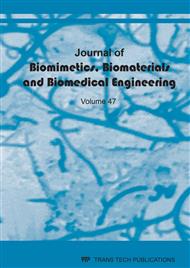[1]
Z. Roja, V. Kalkis, I. Roja, H. Kalkis, The effects of a medical hypnotherapy on clothing industry employees suffering from chronic pain, Journal of Occupational Medicine and Toxicology. 8 (1) (2013) 1-15.
DOI: 10.1186/1745-6673-8-25
Google Scholar
[2]
P.C. Wang, D.M. Rempel, R.J. Harrison, J. Chan, R.R. Beate, Work‐organisational and personal factors associated with upper body musculoskeletal disorders among sewing machine operators. – Occupational and environmental medicine. 64 (12) 2007 806-813.
DOI: 10.1136/oem.2006.029140
Google Scholar
[3]
European Agency for Safety and Health at Work, EU-OSHA. 2000. The state of occupational safety and health in the European Union - Pilot study. Available at: https://osha.europa.eu/en/tools-and-publications/publications/reports/401.
Google Scholar
[4]
Labour Inspectorate Estonia. Available at: https://www.ti.ee/fileadmin/user_upload/failid/dokumendid/Meedia_ja_statistika/Sihtkontrollid/2012_Sihtkontrollide_kokkuvote.pdf.
Google Scholar
[5]
I. Remeza, B. Shestakova, Risk factors and health protection of employees working in sewing industry. In Abstracts of the International Conference on Occupational Health Services 2005. Helsinki: Edita.
Google Scholar
[6]
N. Vezina, D. Tierney, K. Messing, When is light work heavy? Components of the physical workload of sewing machine operators working at piecework rates, Applied Ergonomics. 23 (4) (1992) 268-276.
DOI: 10.1016/0003-6870(92)90155-o
Google Scholar
[7]
L. Van, N. Chaiear, C. Sumananont, C. Kannarath, 2016. Prevalence of musculoskeletal symptoms among garment workers in. Kandal province, Cambodia, Journal of Occupational Health. 58 (2016) 107-117.
DOI: 10.1539/joh.15-0100-fs
Google Scholar
[8]
Riigi Teataja. 2014. Work Ability Allowance Act. Available at: https://www.riigiteataja.ee/en/eli/502042015015/consolide.
Google Scholar
[9]
K. Zheltoukhova, S. Bevan, Töövõimeline Eesti? Luu- ja lihaskonna vaevused ning Eesti tööturg. The Work Foundation. Part of Lancaster University. Available at: http://www.fitforworkeurope.eu/Estonia_Estonian_web.pdf.
Google Scholar
[10]
P.J. Broersen, P.G.H. Mulders, J.M.A. Schellart, A.J. Van Der Beek, The identification of job opportunities for severely disabled sick-listed employees, BMC Public Health. 12 (1) (2012) 156-166.
DOI: 10.1186/1471-2458-12-156
Google Scholar
[11]
K. Reinhold, Risk reduction in textile industry. XVII World Congress on Safety and Health at Work. Manuscripts. Orlando: National Safety Council. (2005).
Google Scholar
[12]
O.J. Sealetsa, A. Thatcher, Ergonomics issues among sewing machine operators in the textile manufacturing industry in Botswana, Work. 38 (3) (2011) 279-289.
DOI: 10.3233/wor-2011-1131
Google Scholar
[13]
G. Singh, H. Vasudev, 2014. Application of human factor engineering in the design and development of products, Journal of Modern Engineering Research. 4 (2014) 65-67.
Google Scholar
[14]
B.C. Amick, C.A. Kennedy, J.T. Dennerlein, S. Brewer, S. Catli, R. Williams, C. Serra, F. Gerr, E. Irvin, Q. Mahood, A. Franzblau, D. Van Eerd, B. Evanoff, D. Rempel, Systematic review of the role of occupational health and safety interventions in the prevention of upper extremity musculoskeletal symptoms, signs, disorders, injuries, claims and lost time. Toronto: Institute for Work & Health. (2008).
DOI: 10.1007/s10926-009-9211-2
Google Scholar
[15]
D. Van Eerd, C. Munhall, E. Irvin, D. Rempel, S. Brewer, A.J. van der Beek, J.T. Dennerlein, J. Tullar, K. Skivington, C. Pinion, B. Amick, Effectiveness of workplace interventions in the prevention of upper extremity musculoskeletal disorders and symptoms: an update of the evidence, Occupational and Environmental Medicine. 73 (2015) 62-70.
DOI: 10.1136/oemed-2015-102992
Google Scholar
[16]
K. Hiir, Prevalence of musculoskeletal disorders, functional status and work ability before and after intervention among sewing machine operators. - Master`s Thesis of Estonian University of Life Sciences. Available at https://sm.ee/sites/default/files/content-editors/eesmargid_ja_tegevused/Uliopilaste_teadustoode_konkurss/2016/kadi_hiir_2016ma_eg_taistekst.pdf (2016).
DOI: 10.4028/www.scientific.net/jbbbe.47.127
Google Scholar
[17]
E. Merisalu, K. Hiir, M. Männaste, A. Traumann, Individual and job related risk factors for musculoskeletal pain among sewing machine operators, Agronomy Research. 14 (4) (2016) 1417-1426.
DOI: 10.1136/oemed-2016-103951.192
Google Scholar
[18]
J. Reste, M. Eglite, A. Rubine, J. Cirule, G. Zubkova, T. Zvagule, I. Vanadzins, Musculoskeletal disorders caused by physical overload: the situation in Latvia, WIT Transactions on Biomedicine and Health. 16 (2013) 73-81.
DOI: 10.2495/ehr130071
Google Scholar
[19]
European Agency for Safety and Health at Work, EU-OSHA. OSH in figures: Work-related musculoskeletal disorders in the EU – Facts and figures. Available at: https://osha.europa.eu/en/tools-and-publications/publications/reports/TERO09009ENC (2010).
Google Scholar
[20]
N. Jahan, M. Das, R. Mondal, S. Paul, T. Saha, R. Akhtar, A.M. Khan, P.C. Banik, 2015. Prevalence of musculoskeletal disorders among the bangladeshi garments workers, SMU Medical Journal. 2 (1) (2015) 102-113.
Google Scholar
[21]
N. Öztürk, M.N. Esin, 2011. Investigation of musculoskeletal symptoms and ergonomic risk factors among female sewing machine operators in Turkey, International Journal of Industrial Ergonomics. 41 (6) (2011) 585-591.
DOI: 10.1016/j.ergon.2011.07.001
Google Scholar
[22]
C.H. Andersen, L.L. Andersen, B. Gram, M.T. Pedersen, O.S. Mortensen, M.K. Zebis, G. Sjøgaard, Influence of frequency and duration of strength training for effective management of neck and shoulder pain: a randomised controlled trial, British Journal of Sports Medicine. 46 (14) (2012) 1004-1010.
DOI: 10.1136/bjsports-2011-090813
Google Scholar
[23]
D.A. Lombardi, K. Jin, T.K. Courtney, A. Arlinghaus, S. Folkard, Y. Liang, M.J. Perry, (2014). The effects of rest breaks, work shift start time, and sleep on the onset of severe injury among workers in the People's Republic of China, Scandinavian Journal of Work, Environment and Health. 40 (2) (2014) 146-155.
DOI: 10.5271/sjweh.3395
Google Scholar


